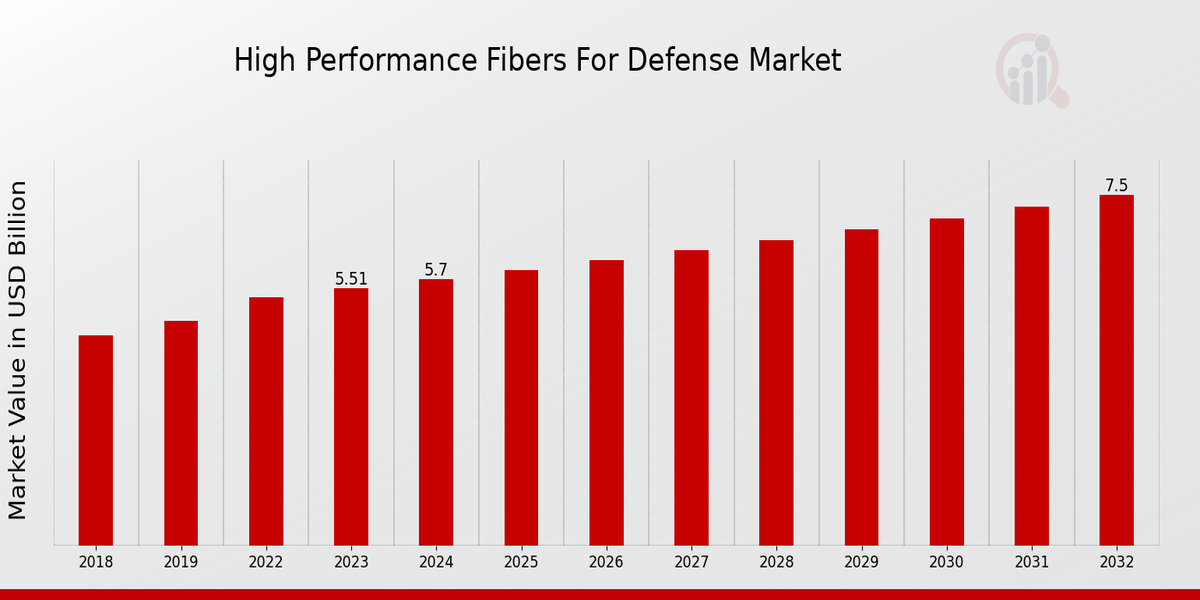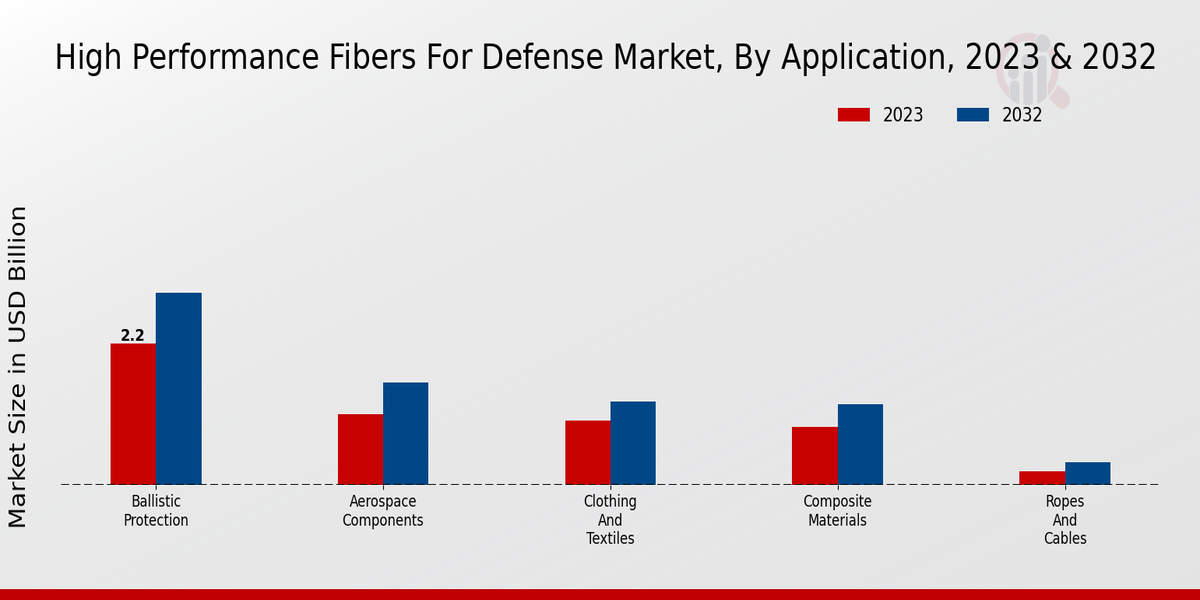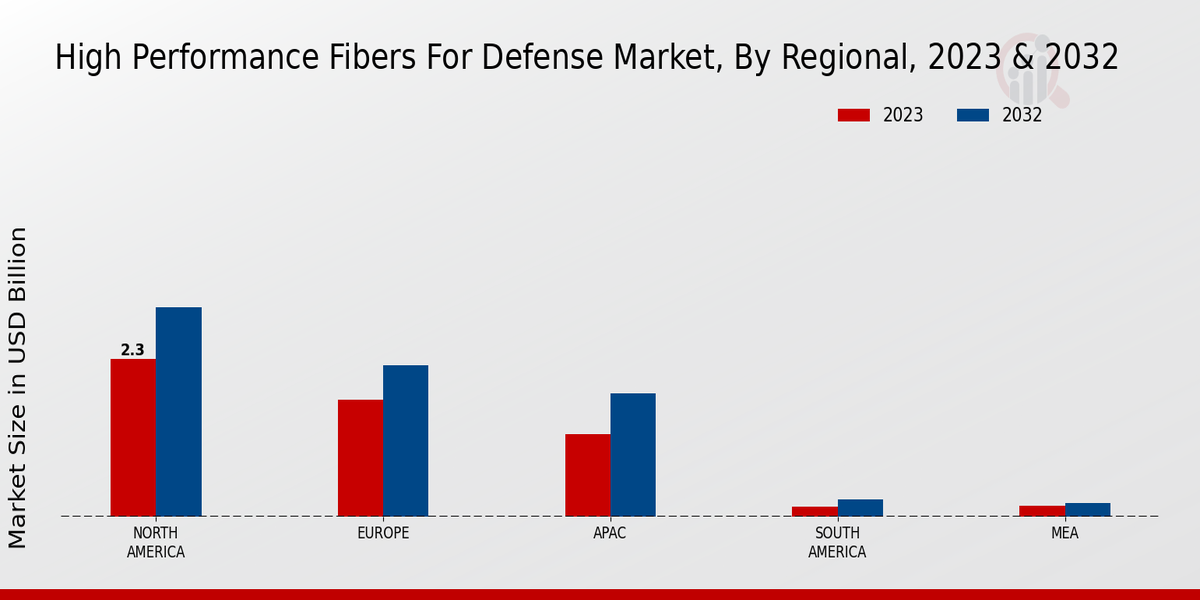Global High Performance Fibers for Defense Market Overview
The High-Performance Fibers for Defense Market Size was estimated at 5.32 (USD Billion) in 2022. The High-Performance Fibers for Defense Industry is expected to grow from 5.51(USD Billion) in 2023 to 7.5 (USD Billion) by 2032. The High-Performance Fibers for Defense Market CAGR (growth rate) is expected to be around 3.49% during the forecast period (2024 - 2032).
Source Primary Research, Secondary Research, MRFR Database and Analyst Review
Key High-Performance Fibers for Defense Market Trends Highlighted
The High Performance Fibers for Defense Market has been growing tremendously as there is a surge in demand for high strength to weight ratio materials for inhospitable defense scenarios. These performance specifications have been accomplished with the introduction of advanced materials which are now becoming crucial in the defense industry for applications such as body armor, military vehicles and other military equipment. As the safety and comfort of soldiers become a priority, defense organizations are beginning to look for high performance fibers which provide optimum protection for soldiers without increasing the overall weight. There is also an increasing demand for advanced composites in various defensive structures which supplements the market development.
The market is bound to have a lot of opportunities especially because the overall defense spending continues to grow. Countries with emerging economies demonstrate a willingness to invest in enhancing their defense forces, thus generating a need for novel materials. There is a growing interest among manufacturers to embed smart fibers that can track temperature and other environmental conditions or react to soldiers. Breakthrough developments in high performance fibers are likely to be achieved through partnerships between material scientists and defense contractors paving new paths for market players. In the recent past, materials sustainability has become a vital area of focus as a development trend.
The current environmental conservation and concern which many defense sectors worldwide has enables focus on the use of eco-friendly methods and materials are forcing the manufacturers to steer towards the production of high-performance fibers with either recycled or sustainable inputs. This transition is consistent not only with the trend in sustainability but also curtails the persistent and expanding legal and societal demands for ethical procurement. There is constant improvement in the sector as there is enhanced understanding of the importance of sophisticated fiber technology in improving defense practices which makes the high-performance fibers sector one of the emerging and innovative segments in the defense industry.
High Performance Fibers for Defense Market Drivers
Increased Defense Expenditure
One of the primary drivers influencing the growth of the High Performance Fibers for Defense Market Industry is the increase in defense expenditure across various nations. Many governments are recognizing the need to enhance their military capabilities in response to evolving threats. The rising geopolitical tensions and security challenges are prompting nations to invest more in robust defense technologies. High-performance fibers play a significant role in military applications, including personal protective equipment, advanced body armor, and lightweight tactical gear.As budgets for defense improve, there is a marked emphasis on integrating state-of-the-art materials that provide superior strength-to-weight ratios, flexibility, and durability. This shift toward adopting advanced materials for defense operations supports the expansion and competitiveness of the High Performance Fibers for Defense Market Industry. Additionally, as countries engage in modernization programs, the demand for high-quality fiber materials that can withstand extreme conditions becomes critical, further fuelling market growth.The move towards more sophisticated defensive strategies ensures that the need for high-performance fibers remains pivotal in enhancing national security. In conclusion, the increasing focus on defense spending will significantly influence the dynamics of the High Performance Fibers for Defense Market Industry, driving the imperative for innovation in fiber technologies.
Technological Advancements
Another significant driver for the High Performance Fibers for Defense Market Industry is the rapid technological advancements in fiber production and processing techniques. Innovations in material science and engineering are facilitating the development of new high-performance fibers with enhanced properties. These advancements lead to the creation of fibers that offer superior ballistic protection, fire resistance, and environmental durability, which are essential for modern military applications.The integration of nanotechnology and composite materials is also contributing to the production of lightweight yet strong fibers, appealing to defense organizations seeking to improve soldier mobility and survivability. As technology continues to evolve, the capabilities of high-performance fibers are expected to expand, resulting in broader applications within the defense sector.
Growing Demand for Personal Protective Equipment
The growing demand for personal protective equipment (PPE) is a critical market driver for the High Performance Fibers for Defense Market Industry. Military and defense personnel require reliable, high-quality protective gear to ensure their safety in various mission scenarios. With increasing awareness of the risks faced in combat environments, the necessity for advanced PPE solutions has surged. High-performance fibers are crucial in the construction of body armor, helmets, and other protective apparel.As defense agencies seek to provide optimal protection against bullets, shrapnel, and environmental hazards, the demand for advanced materials will continue to rise, propelling the growth of this market.
High Performance Fibers for Defense Market Segment Insights
High Performance Fibers for Defense Market Application Insights
The High Performance Fibers for Defense Market showcases a compelling overview within the Application segment, with its valuation expected to exhibit steady growth in the coming years. In 2023, the market's total valuation is recorded at 5.51 USD Billion and is projected to reach 7.5 USD Billion by 2032, accounting for an expected CAGR of 3.49 from 2024 to 2032. Notably, the Application segment encompasses several critical areas including Ballistic Protection, Aerospace Components, Clothing and Textiles, Composite Materials, and Ropes and Cables.Among these, Ballistic Protection stands out as a major player, with a valuation of 2.2 USD Billion in 2023, anticipated to increase to 3.0 USD Billion by 2032. The significance of Ballistic Protection can be attributed to the rising demand for advanced armor solutions in military applications, making it a dominant force within the market. Aerospace Components also demonstrate substantial relevance, with a market value of 1.1 USD Billion in 2023 projected to grow to 1.6 USD Billion by 2032. This segment is critical due to the increasing utilization of high-performance fibers in aircraft construction, where the emphasis lies on enhancing safety and durability.Clothing and Textiles reveal a valuation of 1.0 USD Billion in 2023 and a growth to 1.3 USD Billion by 2032, underscoring the growing need for protective uniforms that integrate performance materials to ensure the safety of military personnel in various environments. Composite Materials are valued at 0.9 USD Billion in 2023, with expectations to expand to 1.25 USD Billion by 2032, driven by the increasing utilization of composite structures in defense applications, which offer improved weight-to-strength ratios. Lastly, Ropes and Cables, while the least valued at 0.21 USD Billion in 2023, are set to reach 0.35 USD Billion by 2032, reflecting their essential role in various military applications where strength and reliability are paramount.Together, these Applications are shaping the landscape of the High Performance Fibers for Defense Market, reflecting trends such as increased military investment and the need for innovation, while also presenting challenges pertaining to material costs and supply chain dynamics. The interdependencies between these segments highlight opportunities for advancements and growth in the industry, paving the way for innovation in defense technologies.

Source Primary Research, Secondary Research, MRFR Database and Analyst Review
High Performance Fibers for Defense Market Fiber Type Insights
The High Performance Fibers for Defense Market, valued at 5.51 USD Billion in 2023, showcases a diverse landscape with significant market segmentation centered around Fiber Type. The demand for high performance fibers is driven by their unique properties such as strength, durability, and lightweight characteristics. Among these, Aramid Fiber plays a crucial role due to its exceptional performance in ballistic protection, making it a major choice for military applications. Carbon Fiber also stands out for its impressive stiffness and high tensile strength, finding its use in various defense equipment.Glass Fiber is recognized for its cost-effectiveness and versatility, contributing to a broad range of applications, while Polyethylene Fiber is gaining traction for its lightweight yet strong attributes, often used in personal protective gear. The overall market is poised for steady growth, fueled by advancements in fiber technology and increasing defense budgets across various nations aimed at enhancing military capabilities. Market growth is further supported by ongoing research into innovative applications and increasing demand for lightweight materials in defense and aerospace sectors.
High Performance Fibers for Defense Market End Use Insights
The High Performance Fibers for Defense Market, valued at 5.51 USD billion in 2023, demonstrates robust segmentation across various end uses including military applications, law enforcement, aerospace, and industrial sectors. Military applications are particularly noteworthy as they leverage advanced fibers for ballistic protection, allowing for increased soldier safety and operational efficiency. Law enforcement agencies also significantly utilize high performance fibers for protective equipment and uniforms, underscoring the growing focus on officer safety.The aerospace sector demands these fibers due to their lightweight yet strong characteristics, facilitating advancements in aircraft design and functionality. Meanwhile, the industrial segment plays a crucial role in providing specialized materials that enhance the durability and performance of defense equipment and gear. Overall, the High Performance Fibers for Defense Market revenue is driven by increasing defense budgets and growing security concerns ly, with ample opportunities for innovation and development in each of these pivotal areas.As the market evolves, trends toward sustainability and advanced manufacturing techniques are further shaping the landscape, presenting both challenges and avenues for growth within the industry.
High Performance Fibers for Defense Market Form Insights
The High Performance Fibers for Defense Market is projected to be valued at approximately 5.51 billion USD in 2023, with expectations to grow significantly in the following years. This market encompasses various forms, such as Fibers, Yarns, Fabrics, and Prepregs, each playing a vital role in enhancing defense applications. Fibers are essential for their lightweight and strong characteristics, contributing to improved material performance under extreme conditions. Yarns, integral for manufacturing, exhibit durability and flexibility, making them crucial for defensive fabric production.Fabrics provide essential protective qualities, while prepregs are significant for their composite applications in military vehicles and equipment. The increasing demand for lightweight materials within defense sectors drives this market's growth, alongside a focus on advanced materials technology, efficiency, and sustainability. However, challenges such as high production costs and limited manufacturing capacity may impact market dynamics. Overall, this market segment represents a critical aspect of the High Performance Fibers for Defense Market industry, with numerous opportunities for innovation and development supported by robust market growth trends.
High Performance Fibers for Defense Market Regional Insights
The High-Performance Fibers for Defense Market is experiencing varied growth across its regional segmentation. In 2023, North America dominates this market with a valuation of 2.3 USD Billion and is projected to increase to 3.05 USD Billion by 2032. This majority holding can be attributed to advanced defense technologies and significant investment in military applications. Europe follows with a significant share of 1.7 USD Billion in 2023, expected to reach 2.2 USD Billion in 2032, driven by robust defense manufacturing and regulatory support.The APAC region, valued at 1.2 USD Billion in 2023 and anticipated to grow to 1.8 USD Billion in 2032, is gaining traction due to rising defense expenditures and regional security concerns. South America and MEA are smaller markets, valued at 0.15 USD Billion and 0.16 USD Billion respectively in 2023, with modest growth expected to 0.25 USD Billion and 0.2 USD Billion by 2032, reflecting opportunities for development in defense capabilities. These distinct market valuations illustrate the overall dynamics, trends, and growth drivers within the High Performance Fibers for Defense Market, showcasing how each region contributes uniquely to the industry's evolution and expansion.

Source Primary Research, Secondary Research, MRFR Database and Analyst Review
High Performance Fibers for Defense Market Key Players and Competitive Insights
The High-Performance Fibers for Defense Market is characterized by a dynamic and increasingly competitive landscape, where organizations are constantly innovating to enhance their product offerings. High-performance fibers are crucial components in defense applications, providing essential properties such as lightweight strength, durability, and resistance to environmental factors. The market is witnessing significant investments in research and development as players strive to develop advanced materials that can meet the rigorous demands of military applications. This sector is poised for growth due to the increased focus on securing national borders, modernizing defense technologies, and developing new materials that can withstand harsh conditions. Analyzing the competitive insights reveals the strategies, trends, and positioning of key players, shaping the future of this vital industry.Hexcel has established a strong presence in the High-Performance Fibers for Defense Market, known for its cutting-edge materials technology and innovative solutions tailored for defense applications. The company’s strengths lie in its comprehensive portfolio of advanced composites, which include a range of high-performance fibers that are essential for lightweight and robust protective gear, aerospace components, and other defense-related applications. Hexcel’s strategic focus on innovation has allowed it to remain at the forefront of developments within the sector, leading to strategic partnerships with various defense contractors, ensuring a steady demand for its products. Additionally, Hexcel’s commitment to sustainability and eco-friendly practices further enhances its reputation in the market, appealing to defense organizations that prioritize environmentally conscious suppliers.DuPont also plays a significant role in the High-Performance Fibers for Defense Market, leveraging its extensive expertise in material science to produce high-quality fibers suited for demanding defense applications. The company is renowned for its technological innovations and has successfully developed fibers that provide exceptional strength, flame resistance, and abrasion resistance, making them indispensable in a variety of military environments. DuPont’s strengths include its strong brand recognition, a wide array of applications, and robust collaboration with governmental and military entities, which positions it advantageously within the market. The company’s unwavering dedication to research and development is driving forward-thinking solutions, enhancing operational efficiencies, and improving the overall performance of defense-related products. DuPont's focus on customization ensures that its high-performance fibers meet the specific needs of defense customers, further solidifying its competitive edge in the industry.
Key Companies in the High Performance Fibers for Defense Market Include
- Hexcel
- DuPont
- Mitsubishi Chemical
- Battelle
- BASF
- Covestro
- Lanxess
- Arafura Resources
- Solvay
- Honeywell
- SGL Carbon
- AGY Holdings
- 3M
- Toray Industries
- Teijin
High Performance Fibers for Defense Market Industry Developments
Recent developments in the High-Performance Fibers for Defense Market indicate significant advancements in materials and applications, with companies such as Hexcel and DuPont leading innovations in lightweight materials that enhance military protection and performance. Mitsubishi Chemical and Battelle are driving research efforts toward developing next-generation fibers with improved durability and resistance to environmental factors. The market has observed increased collaborations, such as BASF and Covestro partnering, to enhance the properties of existing fiber technologies for defense applications. Additionally, growth in companies like Lanxess and Solvay reflects an expanding market valuation, bolstered by rising demand for advanced materials in military attire and equipment. Honeywell and SGL Carbon have also reported increased investments in R&D to optimize their fiber manufacturing processes. Furthermore, AGY Holdings and 3M are making strides in introducing eco-friendly high-performance fibers, aligning with sustainability initiatives. Notably, Toray Industries and Teijin are exploring potential mergers that could strengthen their market positions by consolidating technological expertise and expanding their product ranges, which is expected to reshape the competitive landscape within the industry.
High Performance Fibers for Defense Market Segmentation Insights
High Performance Fibers for Defense Market Application Outlook
- Ballistic Protection
- Aerospace Components
- Clothing and Textiles
- Composite Materials
- Ropes and Cables
High Performance Fibers for Defense Market Fiber Type Outlook
- Aramid Fiber
- Carbon Fiber
- Glass Fiber
- Polyethylene Fiber
High Performance Fibers for Defense Market End Use Outlook
- Military
- Law Enforcement
- Aerospace
- Industrial
High Performance Fibers for Defense Market Form Outlook
- Fibers
- Yarns
- Fabrics
- Prepregs
High Performance Fibers for Defense Market Regional Outlook
- North America
- Europe
- South America
- Asia Pacific
- Middle East and Africa
Frequently Asked Questions (FAQ) :
The High Performance Fibers for Defense Market is expected to be valued at 7.5 USD Billion by 2032.
The expected CAGR for the High Performance Fibers for Defense Market from 2024 to 2032 is 3.49%.
North America is expected to hold the largest market share, with a value of 3.05 USD Billion by 2032.
The market for ballistic protection is expected to reach 3.0 USD Billion by 2032.
Major players include Hexcel, DuPont, Mitsubishi Chemical, Battelle, and BASFBASF, among others.
The aerospace components application market is valued at 1.1 USD Billion in 2023.
The composite materials segment is projected to grow to 1.25 USD Billion by 2032.
The clothing and textiles application is expected to be valued at 1.3 USD Billion by 2032.
The MEA region is projected to reach a market size of 0.2 USD Billion by 2032.
The ropes and cables application market isare valued at 0.21 USD Billion in 2023.

















